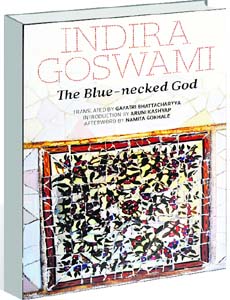|
Helpless in god’s own
land
The Braj, as painted by
Goswami, appears to be obsessed with death. It is also means of
livelihood or an entry into heaven.
Reviewed by Parbina Rashid
The Blue-necked God
by Indira Goswami.
Translated by Gayatri Bhattcharya Zubaan.
Pages 190.
Rs 295
 a rebellious young widow
finds her ‘self,’ an orthodox father crosses religious boundaries
to choose love over righteousness for his only daughter, a
power-stripped Thakur gives up his life under the wheels of Sri
Rangaji’s chariot, an artist chooses a Gandhi topi over his
generations-old practice of making Murlidhar’s idols and
hordes of widows die a little every day in order to save money for
their last rites. Braj, the holy place where Lord Krishna spent his
childhood and adolescence, comes across as a complex abstract painting
that reveals some hidden meaning every time one looks at it. Only,
this painting is not executed in colour and form but in meaningful
words woven by the late Indira Goswami, the literary giant of Assam. a rebellious young widow
finds her ‘self,’ an orthodox father crosses religious boundaries
to choose love over righteousness for his only daughter, a
power-stripped Thakur gives up his life under the wheels of Sri
Rangaji’s chariot, an artist chooses a Gandhi topi over his
generations-old practice of making Murlidhar’s idols and
hordes of widows die a little every day in order to save money for
their last rites. Braj, the holy place where Lord Krishna spent his
childhood and adolescence, comes across as a complex abstract painting
that reveals some hidden meaning every time one looks at it. Only,
this painting is not executed in colour and form but in meaningful
words woven by the late Indira Goswami, the literary giant of Assam.
The Blue-necked God,
Gayatri Bhattacharya’s translation of Indira
Goswami’s novel
written in Assamese, Neelakantha Braja, published in 1976,
highlights the plight of widows living in this sacred city who are
left by their relatives to live an undignified life and die an even
more undignified death.
 The protagonist
Saudamini, a young widow, is forced to leave her Christian lover and
make Braj her new home, along with her parents. She roams around the
streets in search of an answer to her question — is there anyone in
Braj as lonely as she? She finds her answer in characters that she
encounters. Of these characters, Shahsiprova is another young window
who shares a room with a priest in the name of jugal upasana. There
are the old Radhesyamis, who sing bhajans in praise of
the Lord on an empty stomach so that they can accumulate whatever
pittance they earn from the temple priests in order to afford their
last rites. The protagonist
Saudamini, a young widow, is forced to leave her Christian lover and
make Braj her new home, along with her parents. She roams around the
streets in search of an answer to her question — is there anyone in
Braj as lonely as she? She finds her answer in characters that she
encounters. Of these characters, Shahsiprova is another young window
who shares a room with a priest in the name of jugal upasana. There
are the old Radhesyamis, who sing bhajans in praise of
the Lord on an empty stomach so that they can accumulate whatever
pittance they earn from the temple priests in order to afford their
last rites.
Mrinalini, a middle-aged
woman, is forced to lead a frustratingly lonely life, taking care of
her mentally deranged mother and almost-blind father. Chandrabhanu
Rakesh considers himself a useless descendant of ancient ashtadhatu
sculptors of Braj. At the end, he trades his art for a clean
Gandhi topi.
The Braj, as painted by
Goswami, seems to be obsessed with death. For most it is a means of
livelihood, for some it is an escape from the drudgery called life and
for others a direct entry to heaven. Saudamini’s character is the
autobiographical element in the book. The writer, a young widow at
that time, tried to come to terms with her loss by emerging herself
among the widows of Braj. This was also the basis for her research.
The emotional upheaval felt by Saudamini comes across as deep, her
desperation to find the answers real and the narration about the
plight of widows in Hindu society in general is very heartrending.
|